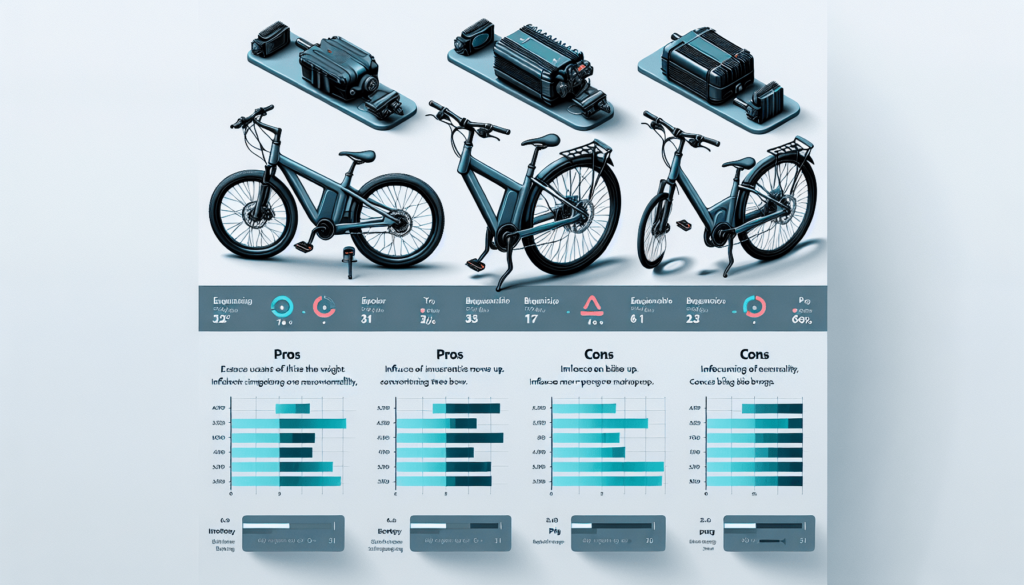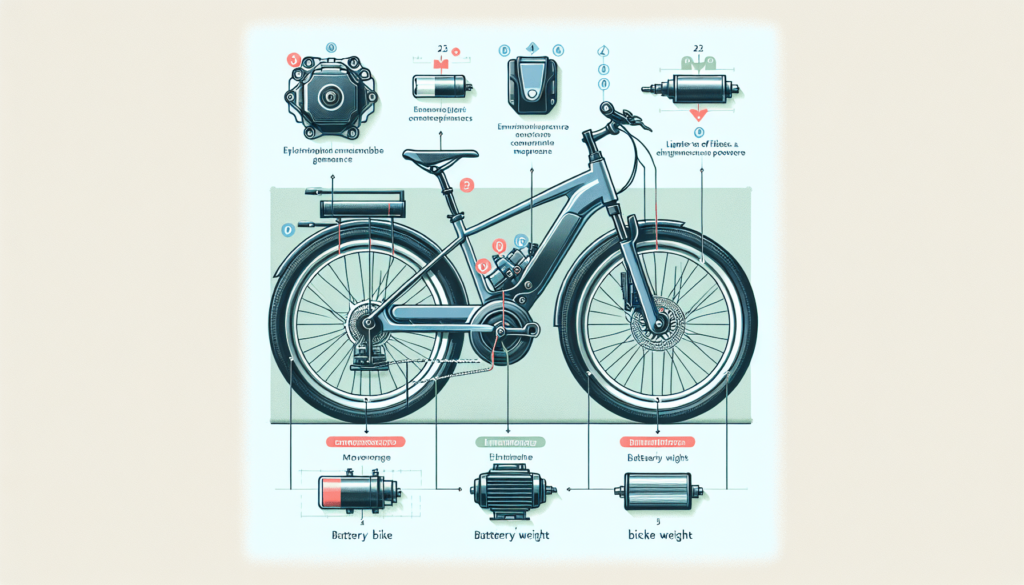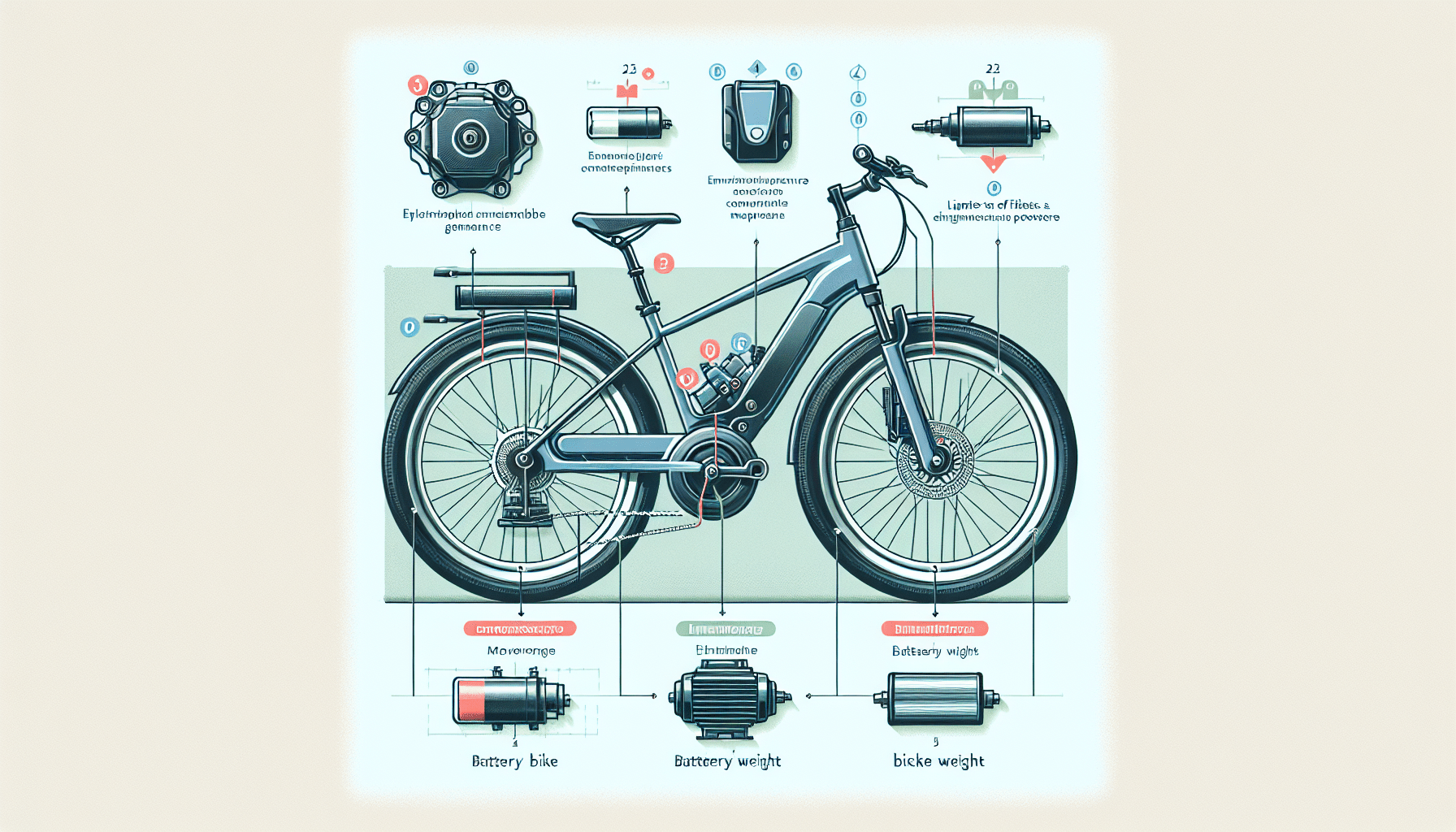Imagine riding a bike effortlessly, cruising up hills and effortlessly gliding along the road. With the rise in popularity of e-bikes, many riders are wondering how the electric motor impacts the weight of their trusty steed. In this article, we will explore the fascinating relationship between e-bike motors and bike weight, uncovering the surprising ways in which these powerful motors influence the overall riding experience. So, if you’re curious to learn more about the impact of e-bike motors on bike weight, hop on and let’s explore together.

Direct Drive Hub Motors
Explanation of direct drive hub motors
Direct drive hub motors, also known as gearless hub motors, are a common type of e-bike motor. As the name implies, these motors are directly integrated into the hub of the wheel. Unlike geared hub motors, direct drive hub motors do not have any internal gears. Instead, they rely on the powerful electromagnets within the motor to propel the bike forward. This design offers a smooth and quiet ride, free from the sound of a chain or gears shifting.
Effect on the weight of the bike
One notable advantage of direct drive hub motors is their inherent simplicity and lack of complex internal gears. This results in a relatively lighter weight compared to other types of e-bike motors. Without the need for gears, direct drive hub motors can be more streamlined and compact, reducing the overall weight of the bike. This weight reduction is particularly appreciated by riders seeking a more maneuverable and agile e-bike.
Comparison to other types of e-bike motors
When comparing direct drive hub motors to other types of e-bike motors, it’s important to consider the trade-offs involved. While direct drive hub motors offer a lighter weight and a smooth ride, they may lack the torque and acceleration provided by other motor types. Additionally, the absence of internal gears means that direct drive hub motors may not be as efficient when climbing steep hills or riding off-road. Therefore, riders who prioritize power and off-road capabilities might opt for a different motor type, such as geared hub motors or mid-drive motors.
Geared Hub Motors
Explanation of geared hub motors
Geared hub motors, as the name suggests, feature internal gearing mechanisms within the motor. This allows for multiple gear ratios to be utilized, providing an extra level of power and torque. Geared hub motors are smaller and lighter compared to direct drive hub motors, thanks to their internal gears. By using gears, these motors can achieve higher speed and acceleration while maintaining efficiency.
Effect on the weight of the bike
The presence of internal gears in geared hub motors adds complexity and some weight to the overall motor assembly. However, due to the smaller size and reduced weight of the internal gears compared to those used in traditional drivetrain systems, geared hub motors are generally still lighter than other motor types. The weight of the gears is offset by the elimination of heavy drivetrain components, resulting in a relatively lightweight e-bike.
Comparison to other types of e-bike motors
Compared to direct drive hub motors, geared hub motors are often considered to provide more torque and acceleration, making them a popular choice for riders who frequently encounter hills or ride on unpaved surfaces. However, the inclusion of gears can introduce a slight amount of noise during operation. Additionally, the internal gears may require occasional maintenance or adjustments to ensure smooth operation. Riders who prioritize power and versatility might find geared hub motors to be an ideal choice for their e-bikes.
Mid-drive Motors
Explanation of mid-drive motors
Mid-drive motors, also known as central motors or crank motors, are located near the bottom bracket of the bike frame, where the pedals are attached. Unlike hub motors, which are integrated into the wheel hub, mid-drive motors transfer power through the bike’s drivetrain. This means that the motor interacts directly with the bike’s gears, utilizing the existing gear system to provide power to the rear wheel. By leveraging the bike’s gears, mid-drive motors can offer a wide range of power options and optimal efficiency.
Effect on the weight of the bike
Mid-drive motors typically add some weight to the bike due to their placement near the bottom bracket and their larger size compared to hub motors. However, because they connect to the drivetrain, mid-drive motors take advantage of the existing gears, eliminating the need for additional internal gears within the motor itself. This makes mid-drive motors generally lighter than geared hub motors while still providing a high level of power and efficiency.
Comparison to other types of e-bike motors
In terms of performance, mid-drive motors excel in situations that require efficient climbing and off-road capabilities. By leveraging the existing gear system of the bike, mid-drive motors provide optimal torque at the rear wheel, allowing riders to conquer steep inclines with ease. Additionally, the central position of the motor contributes to a balanced weight distribution, resulting in a more stable ride. While mid-drive motors may be slightly heavier than direct drive hub motors, their versatility and power make them a popular choice for riders who prioritize performance.
Battery Weight
The significance of battery weight in e-bikes
The weight of the battery plays a crucial role in the overall weight and performance of an e-bike. Batteries are one of the heaviest components, and their weight directly affects the ease of handling, maneuverability, and range of the e-bike. As battery technology continues to improve, manufacturers strive to minimize the weight of the battery without compromising its capacity.
Different battery types and their weights
Different types of batteries are commonly used in e-bikes, each with varying weights. Traditional lead-acid batteries, although less common nowadays, tend to be heavy and can significantly increase the weight of the bike. On the other hand, lithium-ion batteries, which are lighter and more energy-dense, have become the standard choice for e-bikes due to their superior power-to-weight ratio. Depending on the capacity and specific chemistry, lithium-ion batteries can range in weight from a few pounds to over ten pounds.
Effect on the overall weight of the bike
The weight of the battery is a significant factor in determining the overall weight of the e-bike. Heavier batteries can significantly impact the maneuverability and handling of the bike, making it more challenging to navigate tight corners or carry out quick maneuvers. Additionally, heavier batteries can lead to increased rolling resistance, requiring more effort from the rider to maintain speed. Therefore, finding the right balance between battery capacity and weight is crucial, as it directly affects the e-bike’s performance and the rider’s experience.

Frame Design
The impact of e-bike motors on frame design
The introduction of e-bike motors has necessitated adjustments in frame design to accommodate the specific needs and nuances of these powerful systems. E-bike frames must be robust enough to handle the additional weight and torque generated by the motor, ensuring rider safety and optimal performance. The positioning of the motor within the frame also plays a role in maintaining a balanced weight distribution.
Considerations for frame materials and strength
When designing e-bike frames, manufacturers often opt for materials that strike a balance between strength and weight. Aluminum is a popular choice, offering a good combination of durability, lightness, and cost-effectiveness. Some high-end e-bike models may feature carbon fiber frames, which provide even greater strength-to-weight ratio but come at a higher price tag. The key is to ensure the frame can handle the increased forces generated by the motor and provide a stable platform for riding.
Effect on the weight of the bike
The integration of e-bike motors into the frame design inevitably adds some weight to the bike. However, advancements in motor and frame technology have allowed manufacturers to minimize this weight increase while maintaining structural integrity. By strategically placing the motor and optimizing the frame’s geometry, designers can achieve a balanced weight distribution, resulting in a bike that feels nimble and responsive, despite the additional components.
Weight Distribution
Importance of weight distribution in e-bikes
Weight distribution is a crucial aspect of e-bike design, directly affecting the bike’s stability, handling, and overall ride quality. Proper weight distribution ensures that the bike remains balanced and responsive, providing the rider with a comfortable and enjoyable experience. With e-bikes, the added weight of the motor and battery necessitates careful consideration of weight distribution to achieve optimal performance.
Effect of e-bike motors on weight distribution
The integration of e-bike motors, regardless of the type, usually results in a shift in weight distribution compared to traditional bicycles. Hub motors, especially direct drive hub motors, tend to add weight at the rear of the bike, shifting the center of gravity backward. Geared hub motors and mid-drive motors, on the other hand, distribute the weight more centrally due to their placement near the bottom bracket. Understanding this impact on weight distribution is crucial for maintaining stability and control.
Methods to achieve optimal weight distribution
To achieve optimal weight distribution, manufacturers employ various techniques. These include carefully choosing motor placement, strategically positioning the battery, and refining frame geometry. By evenly distributing the weight across the bike, designers can ensure that the e-bike maintains stability and agility, allowing for confident riding and improved overall performance. Additionally, riders can make minor adjustments to the positioning of accessories, such as racks or panniers, to fine-tune the weight distribution to their preference and riding style.
Other Components Affected
Influence of e-bike motors on other bike components
The introduction of e-bike motors has a ripple effect on various other bike components, as the increased weight and forces exerted by the motor require components that can handle these demands. From the drivetrain to the suspension and braking systems, these components need to be carefully selected and designed to ensure compatibility and optimal performance in the e-bike context.
Examples of affected components
One component directly affected by the integration of e-bike motors is the drivetrain, which may need to be reinforced to handle the higher torque generated by the motor. Upgrading to stronger chains, cassettes, and derailleurs can provide the necessary durability and reliability. Additionally, the suspension system may require adjustments to accommodate the increased weight and provide adequate shock absorption. Similarly, the braking system may need to be upgraded to provide sufficient stopping power, since the added weight may place more stress on the brakes.
Weight implications for these components
The need for stronger and more robust components to support the e-bike motor and the added weight can result in an increase in the weight of certain parts of the bike. However, advancements in materials and design have allowed manufacturers to develop lightweight, yet durable, components specifically tailored for e-bikes. By carefully selecting and engineering these components, manufacturers can ensure that the e-bike remains reliable, efficient, and agile without sacrificing structural integrity.
Advantages of Lighter E-bikes
Improved maneuverability
One of the significant advantages of lighter e-bikes is improved maneuverability. With reduced weight, it becomes easier to navigate tight corners, execute quick turns, and handle the bike with precision. Lighter e-bikes can feel more agile and responsive, enhancing the rider’s overall experience, especially in urban environments where maneuverability is paramount.
Easier transportation and storage
The lighter weight of e-bikes makes them easier to transport and store. Whether loading the bike onto a car rack, carrying it up a flight of stairs, or maneuvering it through crowded spaces, a lighter e-bike is more manageable. This is particularly beneficial for riders who may need to transport their e-bikes frequently or have limited storage space at home or work.
Reduced strain on components
A lighter e-bike places less strain on various components, such as the drivetrain, suspension, and braking systems. By reducing the load on these components, they tend to last longer and require less maintenance. This can result in cost savings and a smoother, more trouble-free riding experience.
Disadvantages of Lighter E-bikes
Reduced stability
While lighter e-bikes offer improved maneuverability, they may sacrifice some stability due to the reduced weight. A lighter bike may feel less grounded and more susceptible to being affected by external factors such as wind gusts or uneven terrain. It’s essential for riders to find a balance between weight and stability, considering their riding style and the types of terrain they typically encounter.
Potential compromise on battery capacity
A lighter e-bike may have a smaller or less energy-dense battery to achieve the weight reduction. This can result in a compromise on the e-bike’s range, as the battery’s capacity determines how far the bike can travel on a single charge. Riders who prioritize long-distance rides or extended cycling without access to charging stations may need to carefully consider the trade-off between weight and battery capacity.
Trade-offs with motor power
In some cases, achieving a lighter e-bike may require opting for a less powerful motor. While this may not be an issue for riders primarily using their e-bikes for commuting or leisurely rides, those seeking high performance or challenging terrains may find the reduced motor power limiting. It’s crucial for riders to assess their needs and choose an e-bike with the appropriate motor power that aligns with their intended use.
Considering Weight When Choosing an E-bike
Determining the ideal weight for your needs
Choosing the ideal weight for an e-bike depends on individual preferences and intended use. Riders who prioritize maneuverability and agility may prefer a lighter e-bike, while those seeking stability and extended range may opt for a slightly heavier model. Consider factors such as the terrain you typically ride on, the distance you plan to travel, and the ease of transportation or storage to determine the weight range that best suits your needs.
Balancing weight with other factors
While weight is an essential consideration when choosing an e-bike, it’s crucial to balance it with other factors. Consider the desired power and performance, battery capacity and range, as well as the durability and reliability of the components. Also, take into account factors such as frame design and weight distribution to ensure a well-rounded e-bike that meets your specific requirements.
Importance of test rides and personal preferences
Ultimately, experiencing the ride firsthand through test rides is key to finding the perfect e-bike. What may feel light and maneuverable to one rider may feel too twitchy or unstable to another. Personal preferences, comfort, and riding style also play a significant role in the overall enjoyment and satisfaction with an e-bike. Test riding multiple models, comparing weights, and assessing the overall feel will help you make an informed decision based on your unique preferences.

